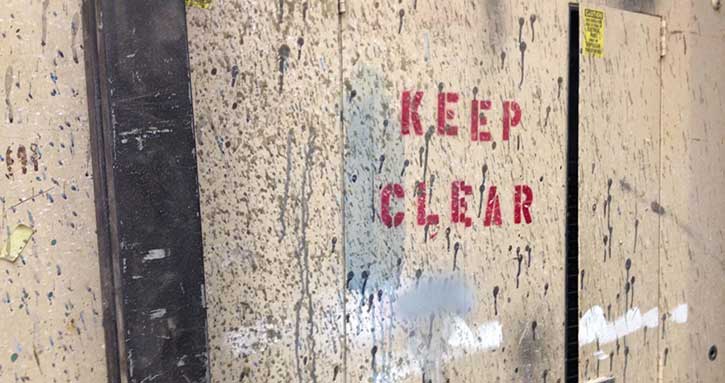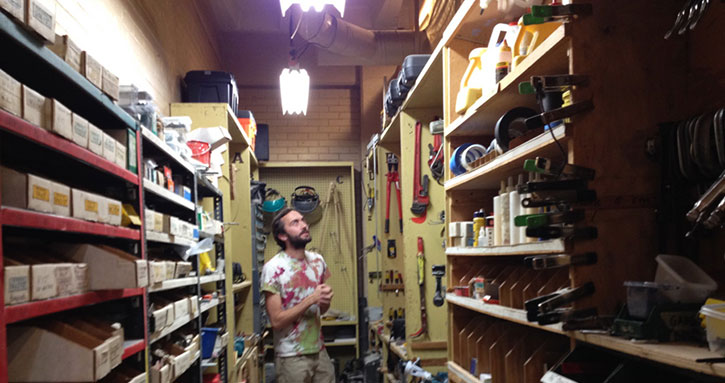Ideas, meet Reality.
M.F.A. Theatre Design student Tim Rothwell on set design and the critical eye

Tim Rothwell wanted a flower over the stage. An enormous flower, one with petals that opened and closed. And he wanted it to light up on cue.
As set designer for the 2014 Meadows Opera production of La Finta Giardiniera (The Pretend Garden Girl) by Wolfgang Amadeus Mozart, the third-year M.F.A. in Theatre Design student had the experience and authority to make such decisions. Working closely with both La Finta director Hank Hammett (senior lecturer and director of Meadows Opera) and Meadows’ professional theatre shop staff, Rothwell spent six months bringing his and director Hammett’s vision to life on the Bob Hope Theatre stage.
All along the way, Rothwell steadily navigated the path between ideas – the essence and heart of design -- and reality – what was actually possible.
The process

The theatre workshop has seen 44 years' worth of productions.
Rothwell began working on the design in the summer of 2013. “The first thing I did was listen to Mozart’s recording to get a feel for the music,” he says. “I tend to have a lot of ideas at the beginning of designing sets, so before I got too far in the initial designs, I went to talk with Hank to hear about his vision. He described how he wanted the set to be different, something other than realism. He wanted ‘weird’ and ‘out-of-this-world.’”
Rothwell took Hammett’s input and began drawing sketches of what the set could look like. “The opera takes place in a garden,” he says. “I started with a lot of umbrellas – hundreds of umbrellas. My initial designs tend to be really busy. I’ve learned that in the beginning, it’s best to just think about design and not the logistics. Let the ideas come first, then figure out how you can make them happen. Over the next several weeks, I met with Hank several times and the design went through multiple rounds of refine, refine, refine.”
Rothwell, who also did the set design for Meadows productions of Major Barbara, Rimers of Eldritch and Slavs!, collaborated with two fellow third-year students: lighting designer Fred Uebele and costume designer Ella Haag. He says designing the set for La Finta has been the most challenging of all the productions he’s worked on to date.
“The La Finta design has been very, very painful in a lot of ways,” he says with a laugh. “But I think I’ve grown and learned a lot more on this set than on any of the others I’ve worked on.” He adds that while some ideas didn’t end up as they were originally envisioned, some ended up better. “There have been a lot of happy accidents.”
Defending the designs

An organized equipment room makes it easy to find the right tool.
When asked what he has found most valuable about his time as an M.F.A. design student, Rothwell says Meadows is particularly good at having its grad students come up with strong ideas and then defending them.
“Every week we have to defend the design we’re doing and show it off,” he says. “You have to be able to talk about your work and critique it and have a critical eye. I find this particularly true for theatre, more than for other arts where students may shy away from being critical of their work. But for theatre, that critical eye is crucial – you have to know and talk about what works and what doesn’t.”
For all the painstaking effort, some design elements in La Finta may not even be noticed by the audience. For example, while no one in the audience can miss the enormous hilly garden set that commands the stage – sturdy enough for all cast members to stand on, high enough to accommodate the lighting grid, low enough for the singers to not lose sight of the audience – they probably won’t notice that all of the Astroturf covering the set was painted a brighter shade of green. Rothwell explains that its original color wasn’t vivid enough to achieve the garden feel he was after. And his coveted large flower that opens and closes and lights up over the set was not a simple thing to construct; Rothwell relied on the pneumatics expertise of staff member J.D. Margetts to have the flower operate seamlessly.
Letting go of the work
After putting in six months of design work, wrestling over what stays and what gets tossed, collaborating with the professional workshop staff and actually putting on the show, there comes the inevitable: the end of the run and the dismantling of a half-year’s worth of effort. To some in the cast and crew it’s a fretful time, a letdown that the show is over all too soon. But Rothwell is fine with letting it go.
“By the time the production is done, I’m okay with it being over. Spending so much time on the set, I tend to see every flaw, every mistake, so by the end of the show, I’m done and ready to move on to other things. The only time I’m really disappointed is when everyone has worked so hard to create something great and only a few people have seen the show. That’s the only time it hurts for me — when great art is not being shared with the world as much as it could be.”
The Meadows difference in design education
Rothwell says Meadows prepares its M.F.A. Theatre Design students to become designers, not set builders in the shop. “We’ve all worked in the shops; we’ve already done that,” he explains. “In a lot of schools they make their grad students work in the shop so they have people on hand to build their shows. In the SMU Theatre Design program, they want you to be a designer, so you assist the professional designers and faculty designers, but also lead the design for the opera and main stage shows. It’s a very clear way to do the work you want to do as a professional.”
The last year of the M.F.A. program is a “transitional” year, transporting the students from the collegiate setting to professional circles. Third-year M.F.A.s work with local professional theater companies such as the Dallas Theater Center, Kitchen Dog Theater, Dallas Opera, the Undermain and more. At the end of the program, all third-year M.F.A. design students fly to New York City with faculty mentor Steve Woods, professor and head of stage design at Meadows, to be presented at the annual Design Showcase East, an annual event that introduces the next generation of designers to theater, film and television executives from New York and the East Coast. Grad students from some of the nation’s top university design programs convene and present their work on costume, set, lighting, makeup and sound design.
In the end, Rothwell says, when the ideas spark on the stage, it’s sublime.
“The greatest compliment a designer can get is that their design works.”
La Finta Giardiniera (The Pretend Garden Girl) by Wolfgang Amadeus Mozart will be performed Thursday, February 6, through Sunday, February 9, 2014 in the Bob Hope Theatre in the Owen Arts Center. Thursday, Friday and Saturday performances are at 8:00 p.m.; Sunday’s performance is at 2 p.m.
Directed by Director of Opera, Senior Lecturer and Chair of the Ensemble Department Hank Hammett and conducted by Professor of Music and Director of Orchestral Activities Paul Phillips, La Finta Giardiniera is an exuberant exploration of the excesses of love. The plot involves attempted murder, violence, fake identities, insanity, mad scenes, three love triangles – and it’s a comedy! As the characters become caught up in a labyrinth of heightened emotions, timeless questions of loyalty, fidelity, honor, friendship, social class, forgiveness and reconciliation come to life in ebullient, sparkling music of great emotional range and imagination by an 18-year-old Mozart. Sung in Italian with projected English translation.
Get tickets online; tickets range in price from $7 to $13. For more information, call the Meadows Box Office at 214.768.2787.
See more behind-the-scenes photos of Tim and the set design process on our Facebook page.